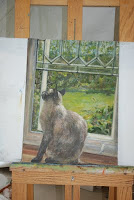
When Elaine Will decided she wanted to be a comic artist, it was no laughing matter.
Although her art form is labelled comic book illustration, there is a lot more depth to the stories behind the pictures on exhibit from now until the December 31 at the Humboldt Museum (HDMG).
Will is the artist featured in the current Artist’s Showcase exhibit, and it was a stroke of luck that it fell at the same time as the Comic Art and Minimates exhibits which opened November 9 at the city’s gallery.
“It doesn’t usually happen that we can tie in the main exhibit with our artist’s showcase feature,” said HDMG curator Jennifer Hoesgen. “This time, we had the opportunity with Chris Bernhard’s comic art and Elaine Will’s cover illustrations.”
Although both artists use the same form, Bernhard’s and Will’s artwork is significantly different in context and appearance, and will give the visitor two perspectives on comic art.
Will grew up in Humboldt and remembers the day her future was sealed. At the age of seven, she recalls buying a comic book and sitting down to read it while her mother was grocery shopping.
“When I finished reading that comic, I thought to myself, ‘this is awesome, I want to do this for the rest of my life!’” she said.
The young artist was able to realize that dream, and the route she followed took her to Bournemouth, England, to study. There she completed a three-year honours arts degree at the Arts University College, obtaining a BA in Illustration.
Five of the pictures in her exhibit date from when she was studying in England, and Will explained that she based these drawings on a song by British post-punk band The Fall.
These framed pictures with purple matting comprise one of the projects she did to complete her degree. Unlike her other pictures on display, they are a set unto themselves, without the sequential art frames normally found in comic book art.
The other framed illustrations are cover art for the comic book series she has been working on in the last two years, Look Straight Ahead.
“There’s a whole sub-genre of comics that are like what I do,” said Will. “They are sort of serious ‘slice of life’ stories.”

Will describes her current series as an “existential story about a teenager who goes crazy and suffers from mental illness.”
“It’s sort of his journey,” she explains. “He’s searching for answers to questions about life, death, love and art.”
Will writes, illustrates and self-publishes her work. Today she says there are no more issues of the first and second volume of Look Straight Ahead available.
The real feather in her cap, though, was when those two volumes were nominated for the Gene Day Award for self-publishing artists, in the 2011 Joe Schuster Awards (Canadian Comic Book Creator awards).
The Joe Shuster Awards are the Canadian equivalent to the Will Eisner Comic Industry Awards in the United States, itself the comic book equivalent to the Oscars.













